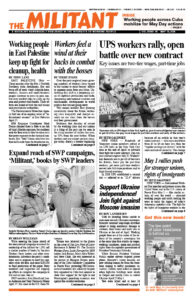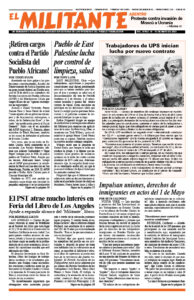On April 26, 1986 — 37 years ago — the people of Ukraine bore the brunt of the world’s worst nuclear disaster, the explosion, fire and meltdown at the Chernobyl power plant. It was a catastrophe denied by Soviet authorities even after radiation detectors sounded the alarm two days later almost 700 miles away in Sweden.
In 2014, at the invitation of Ukraine’s nuclear workers union, two reporters for the Militant, Frank Forrestal and John Studer, today the paper’s editor, went to Chernobyl for a firsthand account of the disaster and its continued effects. “The carelessly flawed design of the nuclear reactor that led to the meltdown. The decision to skip construction of a containment vessel that would have impeded the release of radiation. The refusal to immediately evacuate the area or take any measures to prevent residents from consuming contaminated milk and vegetables,” they wrote, showed “the brutality and contempt for working people by the Soviet government in Moscow.”
Thirty people died in the first few weeks and the number of long-term cancers and deaths has grown into the thousands. The Stalinist rulers’ disdain for workers’ lives played a role in the collapse of the Soviet Union a few years later.
A larger meltdown was only averted by the self-sacrificing efforts of thousands — known as liquidators — who volunteered to contain the disaster, the first of them with no protective gear.
Cuba’s internationalism
“When the explosion at Chernobyl took place, it was a social tragedy,” Liliya Piltyay told Studer in Kyiv. “The authorities didn’t tell anyone the extent of what was taking place.” Piltyay was a leader of the Young Communists in that city who made an international appeal for help in late 1989, one quickly answered by Cuba’s revolutionary leadership.
In contrast to Moscow, Cuba offered free medical treatment. In just three months, 7,000 volunteers built a special medical facility at Tarara outside Havana, and for over 24 years Cuba provided care for 25,000 people affected by Chernobyl radiation poisoning, mainly from Ukraine but also Belarus and Russia. Some 21,000 were children.
Liquidators across the country organized protests against pension cuts ordered by the pro-Moscow regime of Viktor Yanukovych in Ukraine from 2011-13. This was part of the political struggle taking shape in Ukraine that exploded in the Maidan uprising in 2014. Millions of unionists, students and other working people joined in popular mass actions that toppled the Yanukovych regime, drawing the everlasting hatred of Russian President Vladimir Putin.
After the Maidan, “Ukrainians are more conscious, more self-confident,” Sergey Akamovych, a leader of the Chernobyl nuclear workers’ union, told Studer in Slavutych in June 2014. “By challenging our country, Putin has brought us together in defense of Ukraine. Things won’t ever be the same.” Slavutych was built after the disaster made workers’ earlier hometown — Pripyat — uninhabitable.
Moscow’s war on Ukraine
In the first hours of Moscow’s invasion of Ukraine in February 2022, Russian troops seized control of the Chernobyl plant, forcing workers to keep it functioning. A drastic increase in radiation levels was recorded as Russian military vehicles tore up the soil. The Red Forest, located directly behind the plant, remains one of the most contaminated areas on Earth. Yet Russian soldiers were ordered to dig in and live there, with officers indifferent to their health.
“They were digging trenches right close to the reactor,” Halyna Markevych, 82, and one of the area’s few residents, told the press. “We told them to stop. They said: ‘Come on. What kind of radiation could there be?’”
Halyna Voloshyna, 74, who refused to abandon her home near the reactor in 1986, grew angry when the Russians told her they were there to liberate her. She proved to be such a thorn in their side, Russian troops called her “the furious babushka at the end of the lane.” Her youngest son is fighting for Ukraine in the eastern city of Bakhmut today.
On April 1, 2022, Russian troops were forced out of Chernobyl, after their push to seize Kiev and crush the Ukrainian people was smashed by Ukrainian defense forces.
In southern Ukraine, Moscow’s forces took over control of the Zaporizhzhia nuclear power plant, Europe’s largest, which had provided 20% of Ukraine’s electricity. Studer and Forrestal had visited with unionists there as well. Moscow turned the grounds of the plant into a military base, and shelling since has endangered the facility and much more. Electrical generation was shut down there last September.
“We have been operating it safely for over 40 years without a single accident,” the 10,000 plant workers wrote in an August appeal. “But we are powerless before human irresponsibility and madness.”

